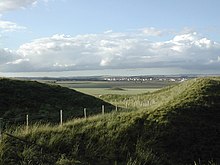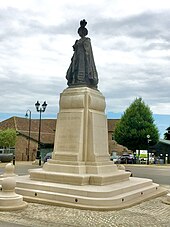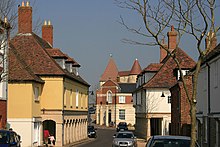Poundbury
| Poundbury | |
|---|---|
 Queen Mother Square, with Strathmore House (right) | |
 Poundbury Location within Dorset | |
| Population | 3,500 |
| OS grid reference | SY671549 |
| Civil parish | |
| Unitary authority | |
| Shire county | |
| Region | |
| Country | England |
| Sovereign state | United Kingdom |
| Post town | DORCHESTER |
| Postcode district | DT1 |
| Dialling code | 01305 |
| Police | Dorset |
| Fire | Dorset and Wiltshire |
| Ambulance | South Western |
| UK Parliament |
|
Poundbury is an experimental new town or urban extension on the outskirts of Dorchester in the county of Dorset, England. It was initiated by architect Léon Krier with the keen endorsement of Charles, Prince of Wales, on whose land it is built (Duchy of Cornwall). Its design is based on traditional architecture and New Urbanist philosophy. Due for completion in 2025, it is expected to house a population of 6,000. Poundbury currently provides employment for over 2,000 people in over 180 businesses. Poundbury has been praised for reviving the low-rise streetscape built to the human scale,[1][2][3] and for echoing traditional local design features but it has not reduced car use, as originally intended, and some[who?] critics have described it as artificially nostalgic.
Mission[]
Poundbury has been built according to the principles of Charles, Prince of Wales, who is known for holding strong views challenging the post-war trends in town planning that were suburban in character. Since starting in 1993, the town has received both criticism and praise from architects and design critics.
The development is built to a traditional high-density urban pattern, rather than a suburban one, focused on creating an integrated community of shops, businesses, and private and social housing. There is no zoning. The planners say they are designing the development around people rather than the car, and they aim to provide a high-quality environment, from the architecture to the selection of materials, to the signposts, and the landscaping. To avoid constant construction, utilities are buried in common utility ducts under the town. Common areas are maintained by a management company to which all residents belong. It consists of 35 percent social housing and is designed for sustainable development,[4] which includes carbon neutrality.[5]
To some degree, the project shows similarities with the contemporary New Urbanism movement. The development brief outlined having a centre built in a classical style and outer neighbourhood areas in a vernacular style, with design influences taken from the surrounding area.[6] The development includes period features such as wrought iron fences, porticos, gravelled public squares, and 'bricked-up' windows; known as blind windows, these traditionally serve an aesthetic function and are widely misattributed to the window tax.[7][8]
History[]

In 1987, the land was selected for development to expand the town of Dorchester. Driehaus Prize winner and New Classical architect Léon Krier was hired in 1988 to design the development. Construction commenced in 1993,[9] and is expected to be complete around 2025, with the north-west quadrant being the last built. The final configuration will support approximately 5,800 people.[10]
Greetings card entrepreneur Andrew Brownsword sponsored the £1 million development of the market hall at Poundbury, designed by John Simpson and based on early designs, particularly the one in Tetbury.[11]
As of 2018, Poundbury has a population of 3,500 residents.[12]
Economy and employment[]

In 2010, Poundbury increased Dorset's county local economy contributing over £330 million; it is expected to contribute £500 million in the next 15 years.[14]
In 2010, more than 2,000 Poundbury residents were working in 180 local businesses. In 2017, the number of businesses increased to 185, providing 2,345 jobs.[15] Businesses include a Waitrose store, a technical company which produces parts for aeroplane wings, and a chocolate factory.
One notable local employer is the breakfast food manufacturer and exporter Dorset Cereals, which since 2000 has employed more than 100 people at its purpose-built barn factory.[16] Reportedly there is space for about 80 additional businesses.[17][18]
Education[]
Poundbury has two primary schools in the catchment area: The Prince of Wales and Damers First School. The latter was already an existing school in Dorchester but in 2017 relocated to Poundbury, where a new school building was built.[19][20][21]
Attractions and landmarks[]

Due to Poundbury's unique looking buildings and plan, the town has been visited by architects, government officials, planners, housebuilders, and developers from around the world.[9]
Tourist attractions are centered around the Queen Mother Square, which includes Strathmore House in honour of Prince Charles’ grandmother Queen Elizabeth The Queen Mother's heritage. In 2016, the Queen Mother statue was unveiled at the square by the Queen and the Duke of Edinburgh.[22] Also in 2016, a pub named the Duchess of Cornwall Inn was opened in honour of his wife, Camilla, Duchess of Cornwall.[23]
Every year in August, the Dorset Food & Arts Festival is held at the Queen Mother's Square attracting thousands of people. The festival showcases the town's fine produce and arts and also raises money for charities.[24][25][26]
In 2018, the Prince of Wales officially opened Poundbury's first church, the Dorchester Community Church.[27]
Reception[]

Poundbury's aesthetics have been variously praised and criticised by several commentators. Writing in Architect magazine, Professor Witold Rybczynski said that "Poundbury embodies social, economic, and planning innovations that can only be called radical."[28]
Among the critics, one described it as "fake, heartless, authoritarian and grimly cute".[29] In 2009, Dorchester Fire Station, designed by Prince Charles, was nominated for a Carbuncle Cup award.[30] Poundbury was intended to reduce car dependency and encourage walking, cycling, and public transport. A survey conducted at the end of the first phase, however, showed that car use was higher in Poundbury than in the surrounding (rural) former district of West Dorset.[31][32][13]
Nonetheless, the project has also received praise. In 2013, on the 20th anniversary of the project, the New Urbanist publication Better Cities and Towns wrote that it was "winning converts".[33] A few years later, British architecture and design critic Oliver Wainwright of The Guardian wrote "Poundbury, the Prince of Wales’s traditionalist village in Dorset, has long been mocked as a feudal Disneyland. But a growing and diverse community suggests it's getting a lot of things right." He argued that its main success was achieving genuine mixed-use development.[13]
According to English philosopher Sir Roger Scruton, "the proportions are human proportions; the details are restful to the eye. This is not great or original architecture, nor does it try to be; it is a modest attempt to get things right by following patterns and examples laid down by tradition. This is not nostalgia, but knowledge passed on from age to age."[34]
Gallery[]

The Whistling Witch row of shops (2008)

Dorset Fire and Rescue Service HQ/Fire station. In 2016 Dorset Fire and Rescue Service merged with Wiltshire Fire and Rescue Service. This meant that the new services H/Q moved to Salisbury and the Dorset building became support offices and Dorchester Community Fire Station.[35]

Brownsword Hall in Poundbury, designed by architect John Simpson and based on earlier traditional designs, particularly one in Tetbury

Dorset Cereals Factory

Apartment block

Holmead Walk

See also[]
- Fairford Leys – a similar project located on the edge of Aylesbury
- Poundbury Hill – an Iron Age hill fort near Poundbury
- Driehaus Architecture Prize
References[]
- Charles, Prince of Wales: A Vision of Britain: A Personal View of Architecture (Doubleday, 1989) ISBN 0-385-26903-X
- Leon Krier: Architecture: Choice or Fate (Andreas Papadakis Publishers, 1998) ISBN 1-901092-03-8
- Sandy Mitchell. "Prince Charles is not your typical radical." National Geographic. May 2006. [1]. Retrieved 9/14/06
Notes[]
- ^ Shields, Bevan (24 July 2021). "Prince Charles' experimental city is proving critics wrong". The Sydney Morning Herald. Retrieved 22 October 2021.
- ^ Jones, Phil; Evans, James (14 May 2008). Urban Regeneration in the UK: Theory and Practice. SAGE. ISBN 978-1-4462-0229-6.
- ^ "A history of Poundbury: The Masterplan". Poundbury.co.uk. Retrieved 31 October 2021.
- ^ "About Poundbury". www.poundburycommercial.com. Retrieved 15 July 2018.
- ^ Pentreath, Ben, How the Poundbury project became a model for innovation, Financial Times, 1 November 2013
- ^ "Poundbury - What's not to like?".
- ^ Niewitecki, Stefan (October 2017). "False Windows – Yesterday and Today". IOP Conference Series: Materials Science and Engineering. 245 (5): 052066. Bibcode:2017MS&E..245e2066N. doi:10.1088/1757-899X/245/5/052066. ISSN 1757-899X.
- ^ Berman, Andrew (23 December 2011). "Blurring the Lines with Blind Windows".
- ^ a b "How the Poundbury project became a model for innovation". Financial Times. Retrieved 12 July 2018.
- ^ https://poundbury.co.uk/wp-content/uploads/2019/08/Poundbury-Factsheet-2019.pdf
- ^ Worsley, Giles (30 January 2011). "A model village grows up gracefully". The Daily Telegraph. London, UK.
- ^ "Prince of Wales visits Poundbury the 'town that Charles built'". ITV. 26 November 2018. Retrieved 31 July 2019.
- ^ a b c "A royal revolution: is Prince Charles's model village having the last laugh?". The Guardian. 27 October 2016. Retrieved 12 July 2018.
- ^ "Poundbury's £330million boost to local economy". 8 August 2010. Retrieved 8 January 2019.
- ^ "Meeting the residents and businesses owners of Poundbury". Dorset.com. 27 March 2018. Retrieved 12 July 2018.
- ^ "Dorset Cereals: Changing the world, one breakfast bowl at a time". The Independent. 28 June 2012.
- ^ "Poundbury: A look at Prince Charles' sustainable village in Dorset, on its 30th birthday". Daily Telegraph. Retrieved 11 July 2018.
- ^ "Queen visits Waitrose in Prince Charles's village Poundbury". Daily Telegraph. Retrieved 11 July 2018.
- ^ "School build starts on Prince Charles's Poundbury estate". BBC. 2 January 2016. Retrieved 12 July 2018.
- ^ "Work set to begin on £10million Poundbury school to replace Damers First School in Dorchester". dorsetecho.co.uk. Retrieved 12 July 2018.
- ^ "Schools and education". celebratingpoundbury.co.uk. Retrieved 18 July 2018.
- ^ "Queen Mother statue unveiled at Poundbury estate". BBC News. Retrieved 12 July 2018.
- ^ "The Duchess of Cornwall Inn Opens in Poundbury". November 2016. Retrieved 12 July 2018.
- ^ "Thousands go along to enjoy the fare at Dorset Food and Arts Festival in Poundbury". The Argus. Retrieved 12 July 2018.
- ^ "Pounbury". dorsetfestival.org. Retrieved 12 July 2018.
- ^ "Celebrate Dorset best at the Dorset food and art festival". Retrieved 12 July 2018.
- ^ "Prince Charles in Poundbury today". Retrieved 21 December 2018.
- ^ Rybczynski, Witold (3 December 2013). Behind the Façade of Prince Charles's Poundbury. Architect.
- ^ Bayley, Stephen (7 December 2008). "I'll show you a real carbuncle, Charles". The Guardian.
To visit Poundbury is to be delivered to the furniture floor of a provincial department store in 1954, translated into architecture. It is fake, heartless, authoritarian and grimly cute.
- ^ 2009-08-05T09:34:00. "Carbuncle Cup 2009 longlist unveiled". Building Design. Retrieved 27 July 2020.
- ^ Watson, G.; Bentley, I.; Roaf, S.; Smith, P. (2004). Learning from Poundbury. Research for the West Dorset District Council and the Duchy of Cornwall. Oxford Brookes University.
- ^ "Stephen Bayley: I'll show you a real carbuncle, Charles". The Guardian. 7 December 2008. Retrieved 14 September 2020.
- ^ Steuteville, Robert (5 November 2013). "At 20, Poundbury is winning converts". Better Cities and Towns. Archived from the original on 10 November 2013.
- ^ Lockwood, Louise (Director) (28 November 2009). Why Beauty Matters (Television production). United Kingdom: British Broadcasting Corporation. Event occurs at 50:02.
- ^ "Dorset and Wiltshire fire services merge". BBC. Retrieved 11 July 2018.
External links[]
| Wikimedia Commons has media related to Poundbury. |
- Populated places established in 1993
- New Urbanism communities
- Villages in Dorset
- Duchy of Cornwall
- Geography of Dorchester, Dorset
- New towns in England
- 1993 establishments in England
- Charles, Prince of Wales
- New Classical architecture
- New towns started in the 1990s







